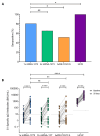Revealing the significance of IL-2 and IL-5 in SARS-CoV-2-specific T-cell responses in kidney transplant recipients
- PMID: 40295737
- PMCID: PMC11702830
- DOI: 10.1038/s44298-024-00015-7
Revealing the significance of IL-2 and IL-5 in SARS-CoV-2-specific T-cell responses in kidney transplant recipients
Abstract
Kidney transplant recipients (KTRs) are at an increased risk of severe COVID-19 due to compromised immune responses. Although vaccination is critical in preventing severe disease, KTRs have attenuated vaccination-induced immune responses due to underlying kidney disease and immunosuppressive therapies. In this study, the effect of different COVID-19 booster strategies on SARS-CoV-2-specific T-cell responses was assessed in KTRs who showed a poor serological response after the first two mRNA-based primary vaccination doses. In these KTRs, a third vaccination dose led to an increase in antibody levels in the majority of patients. Production of IL-2 and IL-5 by SARS-CoV-2 specific T cells positively correlated with antibody levels, with stronger correlations compared to IFN-γ production, the 'traditional' cytokine to measure T-cell responses. Our study underscores the significance a balanced T-cell cytokine response to achieve robust antibody responses in KTRs. Furthermore, we show that multiple cytokines to assess T-cell responses should be explored to identify individuals in need of tailored vaccination strategies.
© 2024. The Author(s).
Conflict of interest statement
Competing interests: The authors declare no competing interests.
Figures





References
Grants and funding
- 10430072010002/ZONMW_/ZonMw/Netherlands
- 10430072010002/ZONMW_/ZonMw/Netherlands
- 10150062010008/ZONMW_/ZonMw/Netherlands
- 10430072010002/ZONMW_/ZonMw/Netherlands
- 10150062010008/ZONMW_/ZonMw/Netherlands
- 10430072010002/ZONMW_/ZonMw/Netherlands
- 10430072010002/ZONMW_/ZonMw/Netherlands
- 10430072010002/ZONMW_/ZonMw/Netherlands
- 10430072010002/ZONMW_/ZonMw/Netherlands
- 10430072010002/ZONMW_/ZonMw/Netherlands
- 10430072010002/ZONMW_/ZonMw/Netherlands
- 10430072010002/ZONMW_/ZonMw/Netherlands
- 10150062010008/ZONMW_/ZonMw/Netherlands
- 10430072010002/ZONMW_/ZonMw/Netherlands
- 10430072010002/ZONMW_/ZonMw/Netherlands
- 10430072010002/ZONMW_/ZonMw/Netherlands
- 10430072010002/ZONMW_/ZonMw/Netherlands
- 10430072010002/ZONMW_/ZonMw/Netherlands
- 10150062010008/ZONMW_/ZonMw/Netherlands
- 21OP+036/Nierstichting
- 21OP+036/Nierstichting
- 21OP+036/Nierstichting
- EMCLHS20017/Health~Holland
- EMCLHS20017/Health~Holland
- 101003589/Horizon 2020
LinkOut - more resources
Full Text Sources
Miscellaneous

